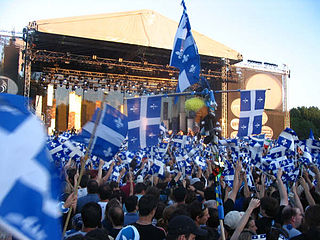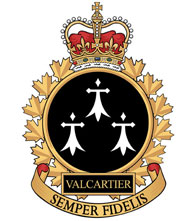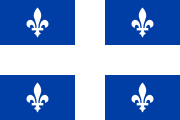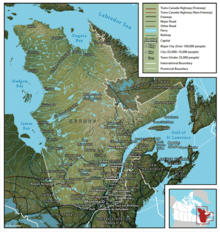
The Université du Québec is a system of ten provincially-run public universities in Quebec, Canada. Its headquarters are in Quebec City. The university coordinates 1400 programs for over 100,000 students. The government of Quebec founded the Université du Québec, a network of universities in several Quebec cities. In a similar fashion to other Canadian provinces, all universities in Quebec have since become public.

The Quebec sovereignty movement is a political movement whose objective is to achieve the independence of Quebec from Canada. Sovereignists suggest that the people of Quebec make use of their right to self-determination – a principle that includes the possibility of choosing between integration with a third state, political association with another state or independence – so that Québécois, collectively and by democratic means, give themselves a sovereign state with its own independent constitution.
The politics of Quebec are centred on a provincial government resembling that of the other Canadian provinces, namely a constitutional monarchy and parliamentary democracy. The capital of Quebec is Quebec City, where the Lieutenant Governor, Premier, the legislature, and cabinet reside.

Quebec nationalism or Québécois nationalism is a feeling and a political doctrine that prioritizes cultural belonging to, the defence of the interests of, and the recognition of the political legitimacy of the Québécois nation. It has been a movement and a central issue in Quebec politics since the beginning of the 19th century. Québécois nationalism has seen several political, ideological and partisan variations and incarnations over the years.

Quebec was first called Canada between 1534 and 1763. It was the most developed colony of New France as well as New France's centre, responsible for a variety of dependencies. Common themes in Quebec's early history as Canada include the fur trade -because it was the main industry- as well as the exploration of North America, war against the English, and alliances or war with Native American groups.

The 12e Régiment blindé du Canada is a Canadian Army armoured regiment based in CFB Valcartier, on the outskirts of Quebec City. The regiment has both a Regular Force and a Primary Reserve unit. The 12e Régiment blindé du Canada's abbreviation is 12e RBC.

2 Canadian Division Support Base Valcartier , formerly known as and commonly referred to as Canadian Forces Base Valcartier, is a Canadian Forces base located in the municipality of Saint-Gabriel-de-Valcartier, 8 nautical miles north northwest of Quebec City, Quebec, Canada. The 2nd Canadian Division is stationed at the base, comprising the 5 Canadian Mechanized Brigade Group and the 2nd Canadian Division Support Group.

A Canadian Forces base or CFB is a military installation of the Canadian Armed Forces. For a facility to qualify as a Canadian Forces base, it must station one or more major units.
Articles related to Quebec include:
2nd Canadian Division Support Base Valcartier, Detachment Montreal, formerly known as and commonly referred to as Canadian Forces Base Montreal is a Canadian Forces Base network located in Montreal, Quebec. The address of CFB Montreal is 6769 Notre-Dame Street.
Anti-Quebec sentiment is a form of prejudice which is expressed toward the government, culture, and/or the francophone people of Quebec. This prejudice must be distinguished from legitimate criticism of Quebec society or the Government of Quebec, though the question of what qualifies as legitimate criticism and mere prejudice is itself controversial. Some critics argue that allegations of Quebec bashing are sometimes used to deflect legitimate criticism of Quebec society, government, or public policies.
5 Canadian Mechanized Brigade Group is a Canadian Forces brigade group that is part of 2nd Canadian Division of the Canadian Army. It is based at CFB Valcartier, near Quebec City, Quebec. The brigade group is the formation responsible for the majority of francophone units of the regular army.
Québécois(e) or Quebecois(e) may refer to:
The Québécois nation motion was a parliamentary motion tabled by Prime Minister of Canada Stephen Harper on Wednesday, November 22, 2006 and approved by the House of Commons of Canada on Monday, November 27, 2006. It was approved 265–16 with supporters in every party in the Commons. The English motion read:
That this House recognize that the Québécois form a nation within a united Canada."
The official name of Quebec City is Québec, in both official languages of Canada. This name is used by both the federal and provincial governments. The acute accent differentiates between the official English name of the city named Québec, and the constitutional English name of the province named Quebec, spelled without any diacritics.
Quebecers or Quebeckers are people associated with Quebec. The term is most often used in reference to descendants of the French settlers in Quebec and people of any ethnicity who live in the province.
The following is a hierarchical outline for the Canadian Armed Forces at the end of the Cold War. It is intended to convey the connections and relationships between units and formations.
Quebecer or Quebecker may refer to:
English-speaking Quebecers, also known as Anglo-Quebecers, English Quebecers, or Anglophone Quebecers or simply Anglos in a Quebec context, are a linguistic minority in the francophone province of Quebec. According to the 2011 Canadian census, 599,225 people in Quebec declare English as a mother tongue. When asked, 834,950 people reported using English the most at home.
Robert Dean was a Canadian politician and trade unionist. He was one of the few Anglophone Quebecers to join the Parti Québécois, which advocates for the independence of Quebec from Canada.












